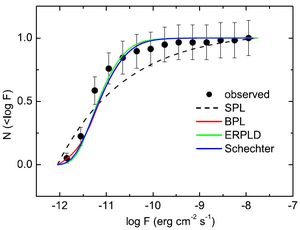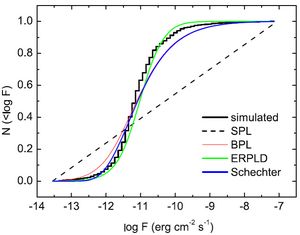We present the optical luminosity function (LF) of gamma-ray bursts (GRBs) estimated from a uniform sample of 58 GRBs from observations with the Robotic Optical Transient Search Experiment III (ROTSE-III). Our GRB sample is divided into two sub-samples: detected afterglows (18 GRBs) and those with upper limits (40 GRBs). We derive R-band fluxes for these two sub-samples 100 s after the onset of the burst. The optical LFs at 100 s are fitted by assuming that the co-moving GRB rate traces the star formation rate, since long GRBs are associated with the deaths of massive stars. While fitting the optical LFs using Monte Carlo simulations, we take into account the detection function of ROTSE-III. We find that the cumulative distribution of optical emission at 100 s is well described by an exponential rise and power-law decay, a broken power law, and Schechter LFs. A single power-law (SPL) LF, on the other hand, is ruled out with high confidence. Rapid follow-up observations in the optical are critical to understand the physical processes of GRBs. There are quite a few small robotic telescopes, in addition to ROTSE-III, that have been built and installed around the world in order to rapidly search for GRB optical counterparts, e.g., GROCSE (Park et al. 1997), TAROT (Klotz et al. 2009), SkyNet, WIDGET (Urata et al. 2011), MASTER, Pi of the Sky (Burd et al. 2005), RAPTOR (Vestrand et al. 2002), REM (Zerbi et al. 2001), and Watcher (Ferrero et al. 2010).With their large fields of view and fast slewing abilities, these telescopes promise to capture large samples of optical counterparts in the near future to accurately constrain the GRB luminosity function at the earliest epoch after burst onset, as what we have done in this work.    Fig. 1. Model fitting results for the cumulative distributions of 58 afterglows observed by ROTSE-III (upper panel), simulated sensitivity function (middle panel), and the “combined (simulated)” sample including 1000 detection simulations and 1000 limit simulations. The solid circles with errors labeled in the left panel as “observed” are the afterglows observed by ROTSE-III. The stepped lines are those from simulations. The type of LF is identified by color as described in the text. Fig. 1. Model fitting results for the cumulative distributions of 58 afterglows observed by ROTSE-III (upper panel), simulated sensitivity function (middle panel), and the “combined (simulated)” sample including 1000 detection simulations and 1000 limit simulations. The solid circles with errors labeled in the left panel as “observed” are the afterglows observed by ROTSE-III. The stepped lines are those from simulations. The type of LF is identified by color as described in the text.
The work by Cui, X. H., Wu, X. F. (corresponding author), Wei, J. J., Yuan, F., Zheng, W. K., Liang, E. W., Akerlof, C.W., Ashley, M. C. B., Flewelling, H. A., G¨oˇg¨u¸s, E., G¨uver, T., Kızıloˇglu,¨ U., McKay, T. A., Pandey, S. B., Rykoff, E. S., Rujopakarn, W., Schaefer, B. E., Wheeler, J. C., Yost, S. A., has been accepted to be published in the ApJ in 2014, please see ApJ, 795, 103 for more details (http://iopscience.iop.org/0004-637X/795/2/103/pdf/0004-637X_795_2_103.pdf). |
